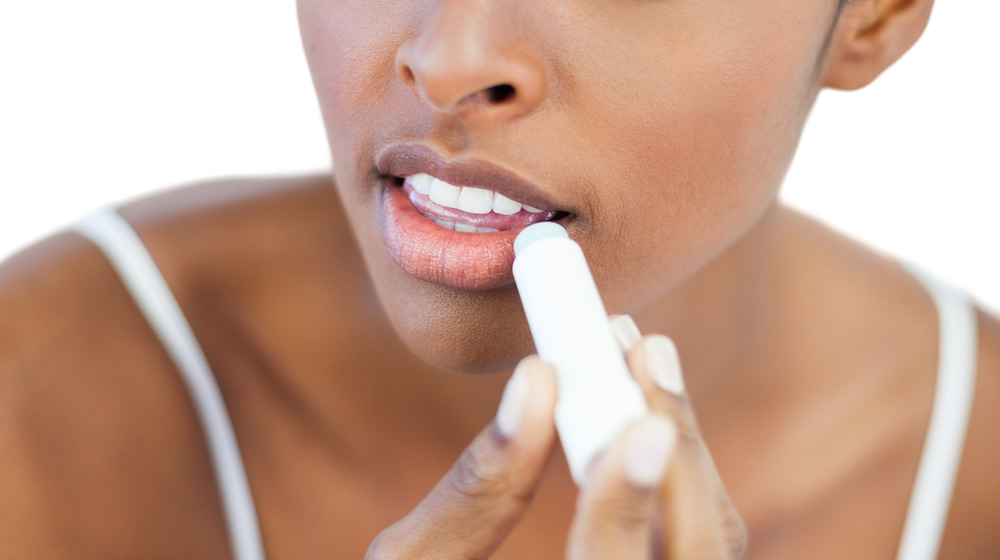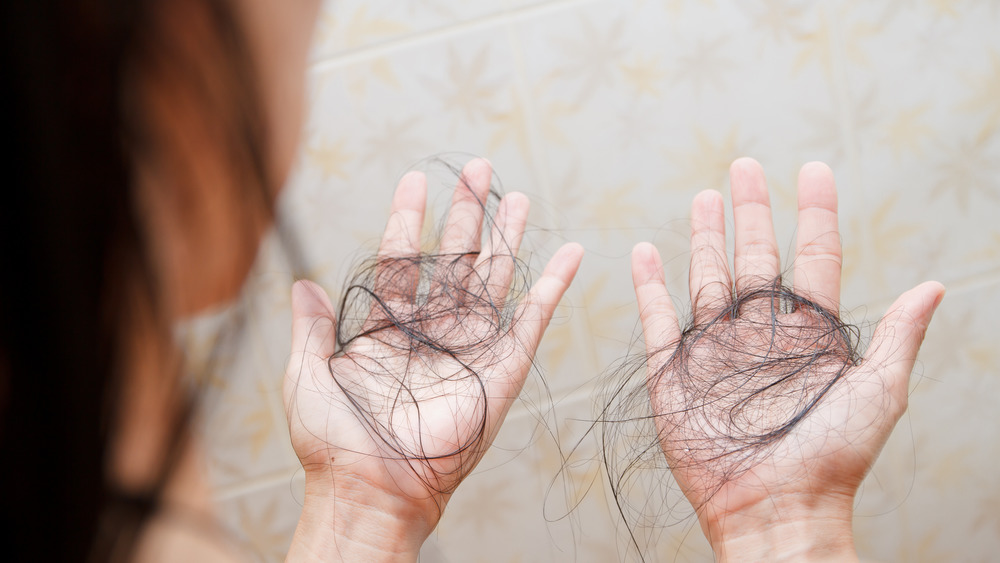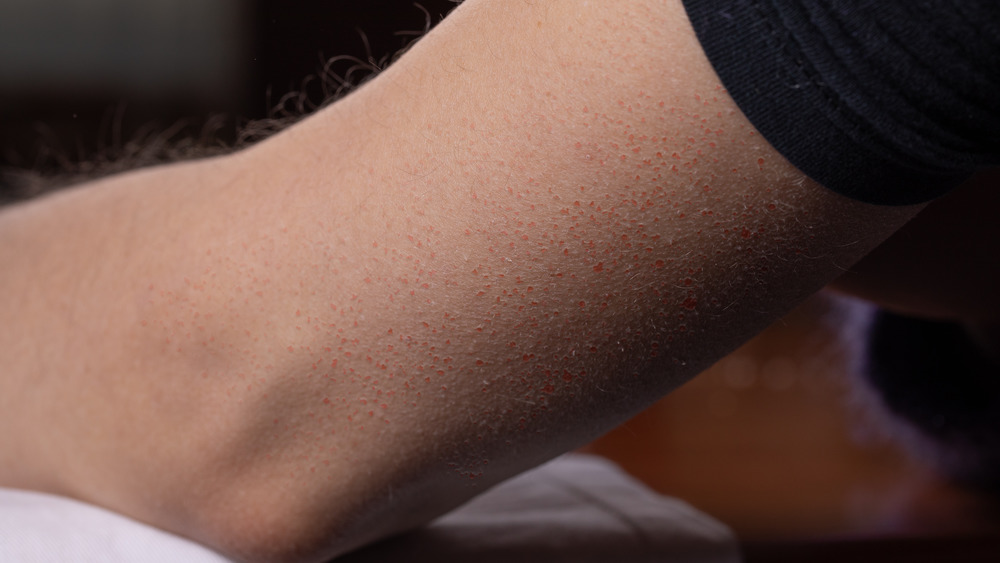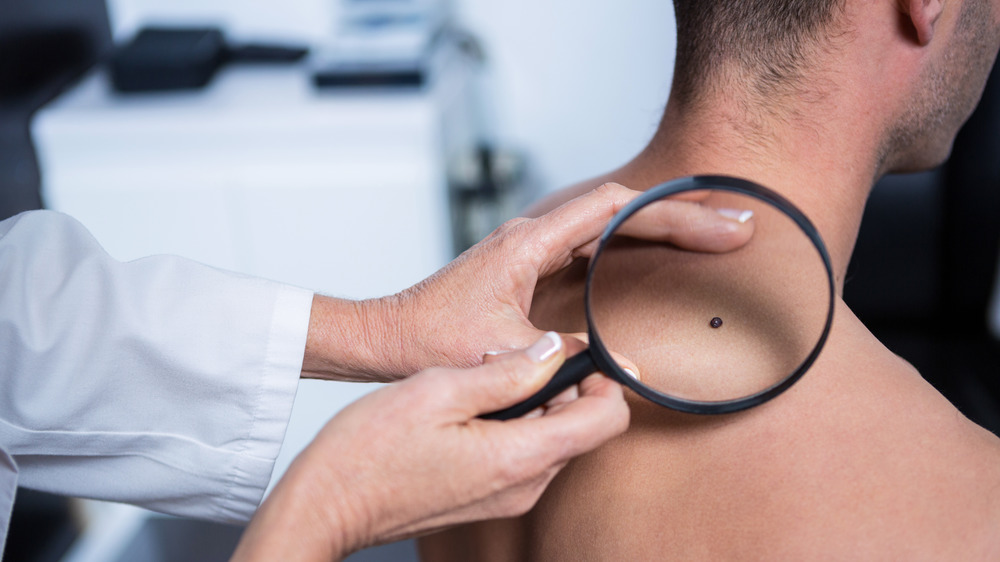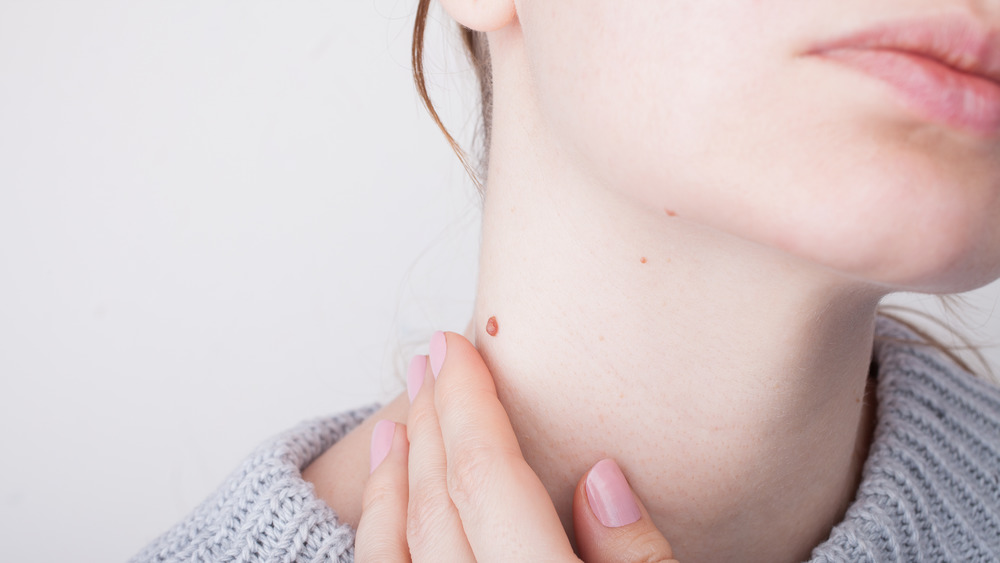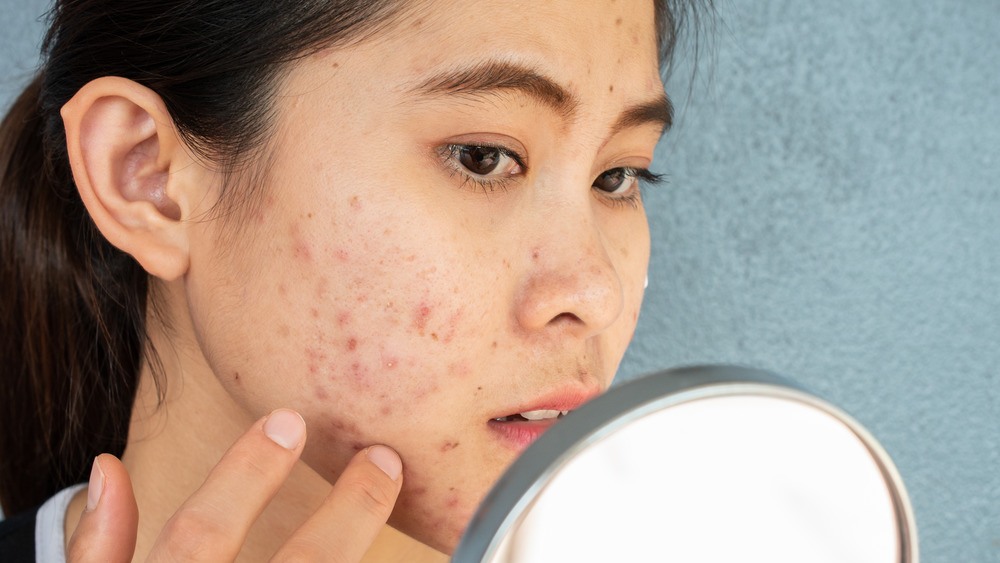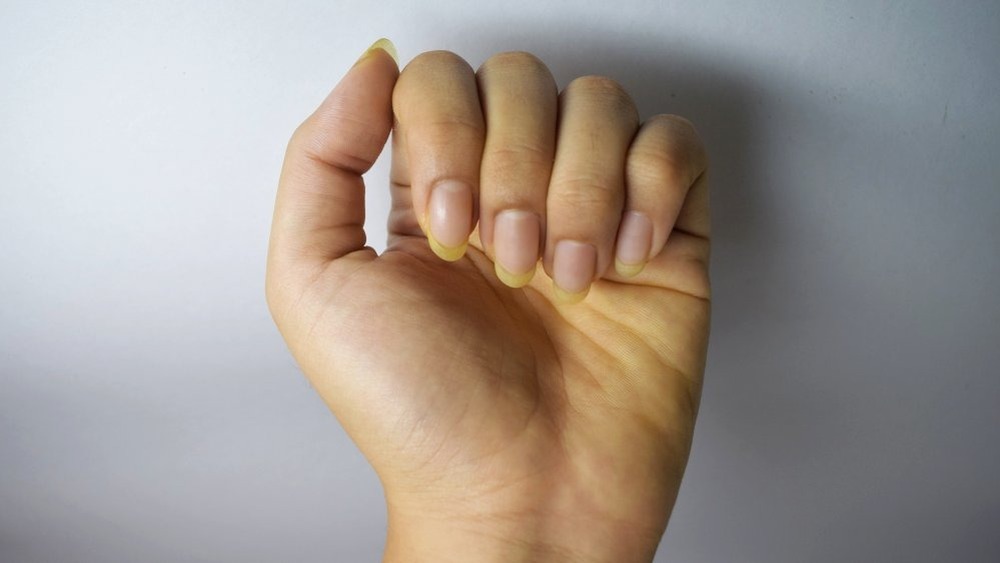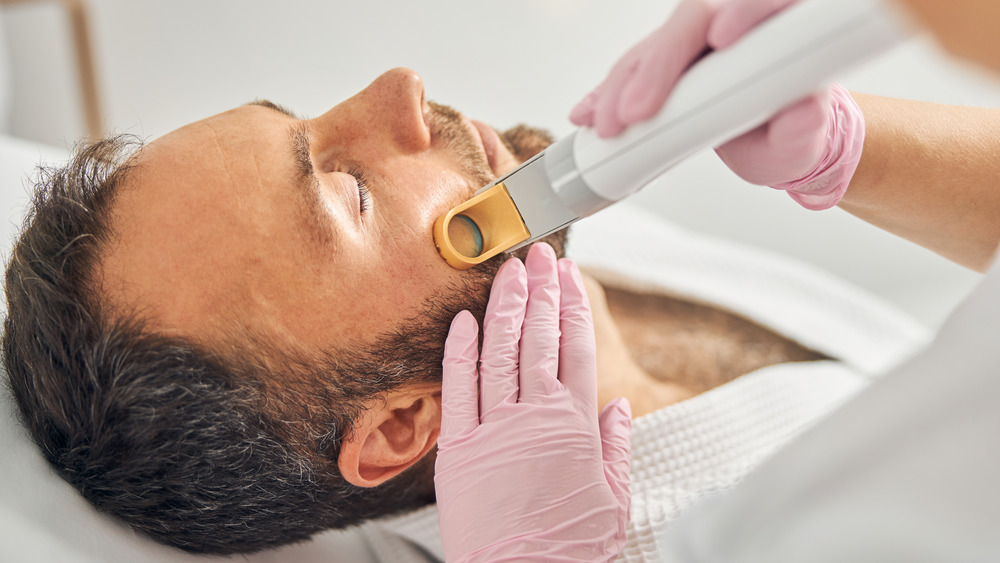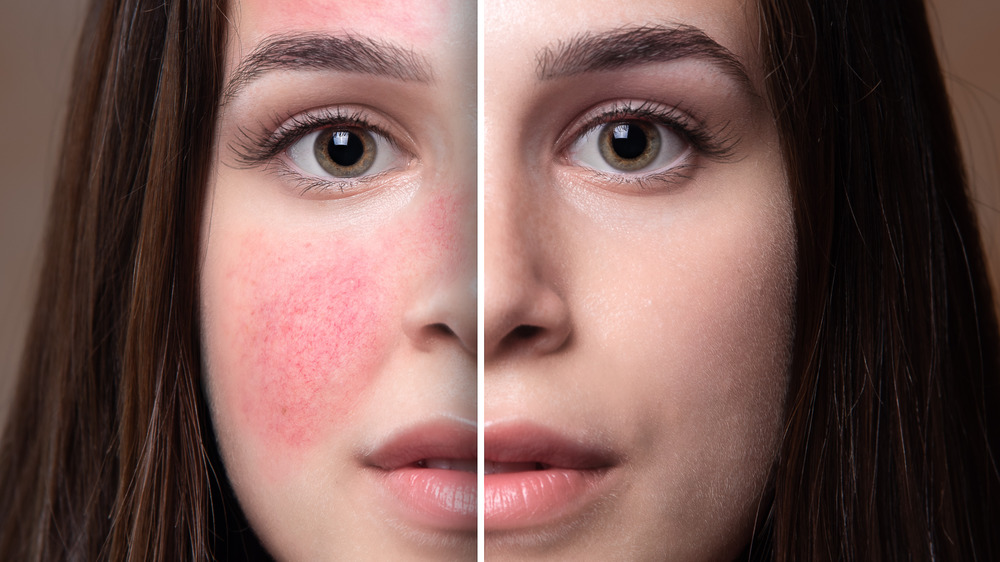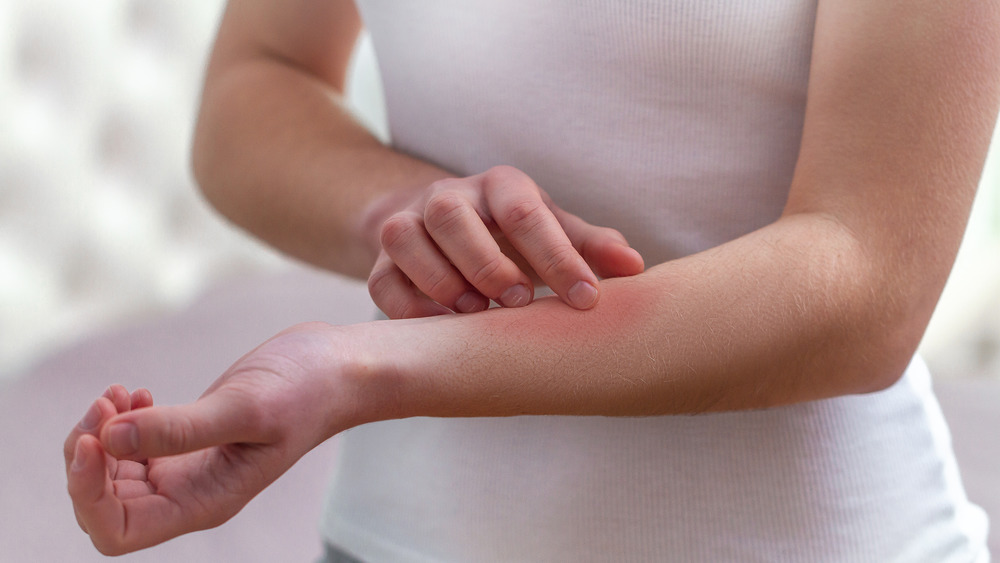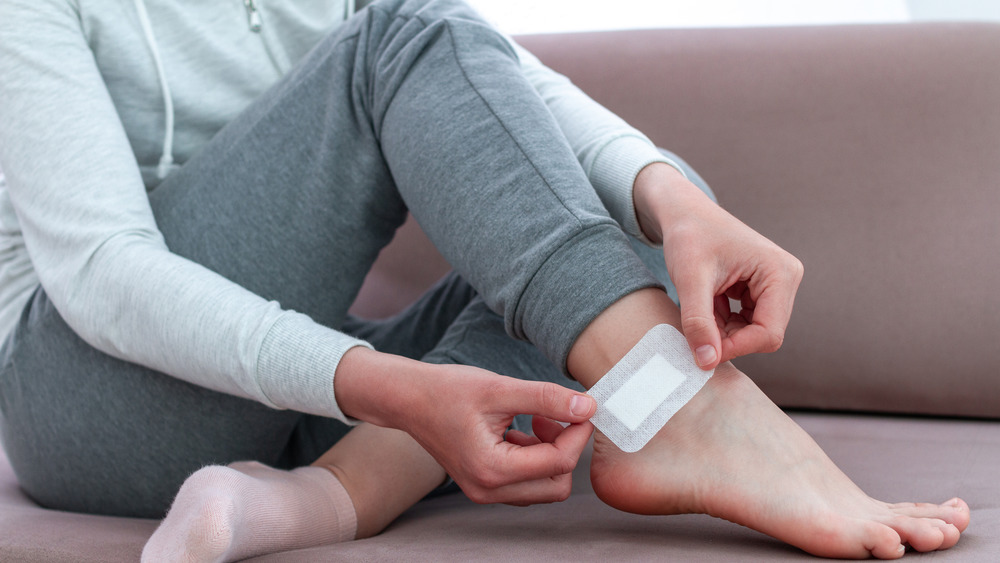You Should See A Dermatologist If This Happens To You
Seeing a dermatologist is important — especially once you consider that your skin is the largest organ of your body, accounting for 16 percent of your total weight (via Healthline). For the average American, that's about 25 to 30 pounds!
All that skin plays an essential part in healthy immune function. "It's our first line of defense against the outside world, including irritants and allergens," dermatologist Heidi Waldorf, an associate clinical professor at the Icahn School of Medicine at Mount Sinai in New York City, told Everyday Health. At the same time, skin cancer is the most common type of cancer in the United States, with approximately one in five Americans developing some type of skin cancer in their lifetime, according to the American Academy of Dermatology.
So, yes, minding your skin is imperative. If you're experiencing any of these symptoms, it may be time to make an appointment with a dermatologist. Many providers even see patients via teledermatology. Read on for skin symptoms to look out for.
See your dermatologist if your scalp is driving you up a wall
Dandruff can be embarrassing, to be sure. Although those flakes may be less noticeable in Zoom calls (phew!), the incessant itching may be getting to you. Scalp itching and scaling can be caused by things like a temporary increase in stress or the use of antibiotics, or could be symptoms of a more serious underlying condition like anemia or thyroid problems, according to Dr. Kseniya Kobets, board-certified dermatologist and director of cosmetic dermatology at Montefiore Health System in the Bronx, New York.
If your dome is flaking and itching like mad, your first move should be to "try over-the-counter shampoos that contain selenium sulfide or pyrithione zinc for one to two weeks," Dr. Kobets told Health Digest. But if the symptoms don't get better, or get worse, it's time to call your dermatologist. "A dermatologist can potentially give a prescription for stronger shampoos and solutions, and evaluate if there are more serious hair concerns happening like autoimmune problems or scarring alopecias."
Check in with your dermatologist if your lips are cracking at the corners
Our lips can be more sensitive and prone to allergic reactions from topical products than other parts of our skin because they lack a protective keratin layer found on most of our body, according to Dr. Mitchell Bressack, an assistant professor of dermatology at Rush University. "The lips, especially the lower lips, often develop actinic (sun-induced) damage, and flaking and cracking of the lower lip can often be an early sign of skin cancer," he told Health Digest.
Drooling in your sleep or excessive lip licking can predispose the corners of your lips to yeast overgrowth and potentially lead to a condition called angular cheilitis, which can be treated with topical prescriptions (via WebMD).
If your lips have been feeling like the Sahara or seem constantly irritated, dermatologist Kseniya Kobets recommends first switching to Vaseline or a petroleum-based ointment. But, she said, "If a lip issue has been present for a few weeks and not resolving for over one month, one may consider seeking the help of a board-certified dermatologist, especially if it's a non-resolving scaly spot or rash in the same spot." This is because it could be an early sign of cancer.
If your hair is shedding excessively, consult your dermatologist
Extreme stress can indeed make your hair fall out. This condition is called telogen effluvium (TE), and it usually starts about three months after the stressful event. "It may be stress on your body from illness or emotional stress such as the death of a loved one," Dr. Shoshana Marmon, board-certified dermatologist and assistant professor of dermatology at New York Medical College, told Health Digest.
"Many conditions can cause hair loss and dermatologists are well-trained to know the differences between them," remarked Dr. Abigail Cline, a co-author with Dr. Marmon on a report in the Journal of the American Academy of Dermatology. However, this shedding usually resolves in about six months' time, Dr. Cline told Health Digest.
If you're diagnosed with TE, try not to panic. "Stressing about it will only cause more hair loss," Cline explained. That said, it's still important to see your dermatologist. "There are other more serious conditions that can leave the scalp with permanent scarring. If patients have any bald patches, redness, itching, or pain on their scalp they should visit their dermatologist for an evaluation," she continued.
Battling bookoos of bumps? Tell your dermatologist
The dreaded "chicken skin." If your upper arms often have areas of dry, rough goosebumps — and less commonly your cheeks, thighs, or rearend — you may have a condition called keratosis pilaris, aka KP. "Keratosis pilaris is a common condition in which there is thickening of the skin around the openings of the hair follicles," dermatologist Mitchell Bressack told Health Digest. He said moisturizers with alpha-hydroxy acid, salicylic acid, and retinoic acids can improve the roughness.
New York-based dermatologist Kseniya Kobets told us if over-the-counter remedies don't work and you still feel plagued by KP, "then you should see a dermatologist for additional prescription topicals." She continued, saying, "I always set my patients' expectations about KP: It is a chronic problem which we cannot make go away, but we can try to make it feel and look better." Chemical peels and cosmetic lasers can also help.
According to both dermatologists, excessive ingrown hairs are related to acne and hormonal imbalances, so be sure to mention them to your dermatologist if you feel they're getting out of hand.
Don't wait to tell your dermatologist about that new skin growth
Was that mole there last month? If not, you shouldn't necessarily freak out, according to dermatologist Mitchell Bressack. "New skin lesions can appear at any time in life, so if someone sees a new growth, they should not jump to the conclusion that they have skin cancer." That being said, the Skin Cancer Foundation recommends you check your whole body, up and down, front and back, once a month for any new, changing, or unusual skin growths.
When caught early, skin cancers are highly treatable and curable, per the foundation. Melanoma is the most serious form of skin cancer and if left undetected, it can spread to your lymph nodes and internal organs, which could be fatal.
While people with fair skin are more likely to be diagnosed with melanoma, the disease can occur in all skin tones, according to the American Academy of Dermatology. Additionally, people with skin of color are more prone to skin cancer in areas that don't see much sun, like the bottoms of the feet and the palms of the hands, inside the mouth, and the groin.
Schedule an appointment with your dermatologist if a mole starts to change
Monthly head-to-toe skin checks can help you know if a mole or lesion has changed in appearance, in which case it's time to call your dermatologist. "Moles often undergo change over the course of one's life," dermatologist Mitchell Bressack told Health Digest. But if moles exhibit any signs from the "ABCDE rule" — asymmetry, border irregularity, color irregularity or changes, diameter greater than a pencil eraser, or evolving appearance — then you should be evaluated by a dermatologist as soon as possible (via Skin Cancer Foundation).
If a skin lesion itches or bleeds — even if it's smaller than a pencil eraser (about 6 millimeters) — you should get it looked at right away. Your doctor can determine if the mole is benign or if it warrants a biopsy. While melanoma usually looks mole-like, other kinds of skin cancer have different visual characteristics, according to the American Academy of Dermatology. Basal cell carcinoma, the most common type of skin cancer, can look like a pearly bump, a skin-colored growth, or a pinkish patch of skin. Squamous cell carcinoma more often appears as a scaly patch of skin, a hard red bump, or a sore that heals and then comes back again.
Tell your dermatologist if your acne is increasing
For some of us, it feels like pimples never end. Whether you're 15 or 45, acne is the pits. Maybe you had finally nailed down a great skincare routine, but then maskne (face mask acne) became a thing. It's relentless!
If drugstore go-tos like products with salicylic acid or benzoyl peroxide just aren't zapping your zits, you should make an appointment with a dermatologist, especially if you're developing scarring or noticing changes in the texture of your skin, according to dermatologist Kseniya Kobets. A dermatologist can help you figure out what's triggering your acne and recommend appropriate solutions, including topical medications, oral antibiotics, or, if you have deep cysts, injections to bring down inflammation.
Depending on the treatment, acne may get worse before it gets better — what some people call "purging" — especially if your doctor prescribes a topical retinoid. But keep the faith. Improvements can be seen as soon as two to four weeks from starting treatment, Dr. Kobets confirmed. Light chemical peels can complement these treatments, according to the dermatologist, by helping dry up and clean out the pores and by reducing superficial scarring, but the peels are usually not covered by insurance.
If your nails are discolored or have taken on a strange texture, consult your dermatologist
The eyes may be a window to the soul, but did you know the nails are a window to health? It's true, your nails can teach you some surprising things about your health. Some nail irregularities, like horizontal lines across your nails (Beau's lines), are harmless and can occur after an illness or injury, when your body switches energy from growing your nails to repairing itself (via Mayo Clinic). But other nail changes, like discoloration, indentation, or pitting, can mean something deeper is going on, according to board-certified dermatologist Kseniya Kobets. "Nails can have changes just like skin, related to eczema, psoriasis, and other autoimmune disorders like lichen planus," Kobets told Health Digest.
"Dry, brittle, yellow nails may be psoriasis or may be a fungal infection," but you should get the condition tested by a doctor before you begin an over-the-counter treatment, Dr. Kobets advised. Excessively curving nails (a condition called clubbing) can be a sign of lung dysfunction or other internal organ issues, while dark spots under the nails, which might extend to the cuticle, could be a sign of melanoma (called subungual melanoma), Dr. Kobets said. This is more common in patients with skin of color. When in doubt, ask your doctor.
Is your face betraying your age? Your dermatologist can help
We all get older, alas, there's no changing that. But your skin doesn't have to show it! And Botox, while effective, is not the be-all and end-all. The first thing you should be doing, if you aren't already, is wearing sunscreen every day. This is true no matter your complexion. "We still want to protect the collagen and elastin that makes our skin smooth and supple in all skin types!" Dr. Kseniya Kobets, as assistant professor of dermatology at the Albert Einstein College of Medicine, told Health Digest. "A daily moisturizer with SPF 30 to 68 is a good habit to start [because] a good skincare regimen is essential to protect young skin and treat mature skin."
Beyond that sage advice, there are all kinds of treatments for wrinkle reduction and prevention, skin tone smoothing, and more. "Nowadays, everyone is in the public eye and having such busy schedules [that] low-downtime, non-invasive treatments are becoming more and more popular" Dr. Kobets said. Ultrasound tightening, light chemical peels, non-ablative (creating heat without injury) laser treatments with platelet rich plasma injections — these are just a few of the rejuvenating treatments a board-certified cosmetic dermatologist can offer.
See your dermatologist if your face is frequently flushed
Rosy cheeks may be desirable, but looking bashfully blushed all the time may not be what you're going for. Rosacea is a chronic reddening of the skin (erythema) on the nose, cheeks, forehead, and chin, which can resemble a sunburn, according to the National Institute of Arthritis and Musculoskeletal and Skin Diseases. It can also cause visible, small broken blood vessels, called telangiectasia. It may come and go, but over time it can become more frequent or even permanent (via NYU Langone Health).
Certain things seem to trigger it, like spicy foods, alcohol, and even stress, but triggers can be different for everyone. Other forms of rosacea can look like acne (papulopustular rosacea), cause thickening of the skin, especially on the nose (phymatous rosacea), and lead to eye problems (ocular rosacea), according to NYU Langone Health. Sometimes a patient can have more than one kind at the same time.
While the condition is not curable, mild cases usually don't require treatment, and moderate cases usually respond well to both oral and topical treatments, according to dermatology professor Dr. Mitchell Bressack. A dermatologist may also be able to help you figure out your triggers, so you can avoid them and reduce rosacea flares.
If you have a mysterious rash that won't clear up, see your dermatologist pronto
Boy, oh boy. A rash could be almost anything! And it could be accompanied by itching, dry or cracked skin, bumps, or blisters. If you came into contact with a mystery plant or started using a new topical product, it could be contact dermatitis. If you can deduce the offending substance and avoid it, your rash should resolve within two to four weeks. Over-the-counter hydrocortisone can help with your symptoms, but should not be used longer than one week (via WebMD). If the rash lasts longer than three weeks, involves your face or genitals, or is sudden and painful, however, you should make an appointment to see a dermatologist, according to the Mayo Clinic.
In an interview with Health Digest, Dermatologist Kseniya Kobets added that "a rash that is acutely spreading, and starting to involve a large portion of the body, especially one which is blistering on skin or oral mucosa [inside of your mouth], and/or is accompanied by fever, should be considered urgent and requires a visit to urgent care or an ASAP visit with a dermatologist."
See your dermatologist if you're dripping buckets
Sweating in hot weather is normal — just as it's normal to perspire during exercise or while feeling nervous. But if you're sweating for no discernible reason, or if your sweat seems excessive or embarrassing, you should definitely talk to your dermatologist about it. Excessive sweating, aka hyperhidrosis, could be a sign of an underlying thyroid condition, or a side effect from a prescription medication, including some antidepressants (via Healthline). It also runs in the family (thanks a lot, mom and dad!).
The good news is, hyperhidrosis is treatable. Topical remedies include prescription-strength antiperspirants that contain aluminum chloride or medicated wipes sold under the brand name Qbrexza. Botox injections can also be used to address sweating in the underarms and even the palms of the hands.
Dermatologist Kseniya Kobets told Health Digest that there are now several FDA-approved medical devices that can be used to destroy the sweat glands and lead to lasting improvement. Unfortunately, not all of these treatments are covered by insurance. Talk with your dermatologist to explore which options fit your condition and budget.
A sore that won't heal requires a visit to the dermatologist
Okay, we confess: We may have absent-mindedly picked at a spot or a scab on our skin once or twice. But we know, and you should, too, that it's a bad habit — one that can lead to scarring and infection (via Healthline). But what if you've been super disciplined, and that sore still won't heal on its own?
"I always tell my patients if a spot has not healed over one month, it would be a good idea to see a dermatologist," Dr. Kseniya Kobets, a New York-based dermatology physician, told Health Digest. "Often, these 'sores' can be non-healing pink pearly bumps or scaly pink papules that scab up or bleed, which could be concerning for a non-melanoma type of skin cancer (such as basal cell carcinoma or squamous cell carcinoma)."
Don't panic automatically, though. It could also be something harmless, like seborrheic keratosis (noncancerous skin growths) or a wart that's gotten irritated, Dr. Kobets explained. Nevertheless, it's best to make an appointment with your dermatologist, who will be able to tell what's what and recommend appropriate treatment.
Haven't been to see your derm in over a year? It's time
Your primary care doctor can check your skin for new or concerning growths at your annual checkup, but you should also consider seeing a dermatologist every year — especially if you have had multiple sunburns during your life, fair skin, family history of skin cancer, atypical moles, red hair, or are a recipient of an organ transplant (via Skin Care Foundation). During your annual exam, your dermatologist will check your skin from head to toe, just to make sure you haven't missed anything during your monthly self-checks.
If you've had skin cancer in the past, you should definitely be seeing your dermatologist every year. "Multiple studies have shown people who have had skin cancer have a much higher risk of developing additional skin cancers over time," dermatologist Mitchell Bressack told Health Digest. "Early detection can result in smaller scars, and, in the case of melanoma, potentially be life-saving." If you're on any kind of prescription medications for skin ailments, then you should also be seeing your dermatologist once every trip around the sun.



